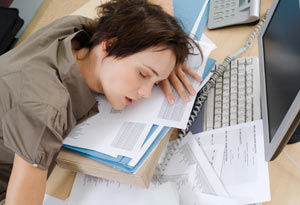6 Easy Ways to Stay Alert During the Workday (Without Sugar or Caffeine!)

Photo: Thinkstock
You can beat the 4 p.m. slump-without sugar, caffeine, or a nap.
Are your eyelids getting droopy? Is that a yawn? It must be late afternoon. Look around and you'll notice that just about everyone experiences an energy lull between about two and five o'clock. Though a siesta is customary in many cultures, few of us can afford the luxury of an afternoon nap. "In industrialized countries, we view this tiredness as an intrusion, but it is the way nature intended us to feel," says David Dinges, Ph.D., chief of the psychiatry department's Division of Sleep and Chronobiology at the University of Pennsylvania School of Medicine. Chronobiologists, scientists who study the body's biological rhythms, blame our midafternoon drowsiness on the body clock, located in the hypothalamus, which also regulates such vital functions as heart rate, hormone production, and blood pressure. "The body clock, in interaction with the sleep drive, appears to produce a dip in alertness in the afternoon," explains Dinges.
Other experts link the lull more directly to body temperature, which the hypo- thalamus also controls. When body temperature decreases, many mental and cognitive skills wane as well. "Body temperature rises in the morning, peaks around noon or one o'clock, and then, in the afternoon, drops slightly," says Michael Smolensky, Ph.D., director of the Center for Chronobiology and Chronotherapeutics at Memorial Hermann Hospital in Houston and co-author of The Body Clock Guide to Better Health (Henry Holt & Company). If you alter your sleep/wake schedule, your body clock follows suit, but it takes several days. Typically, between 5 and 7 P.M. your temperature and energy peak again; from there they gradually decline, dropping you into sleep at night.
The best 6 strategies for tackling mid-afternoon malaise



